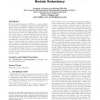Free Online Productivity Tools
i2Speak
i2Symbol
i2OCR
iTex2Img
iWeb2Print
iWeb2Shot
i2Type
iPdf2Split
iPdf2Merge
i2Bopomofo
i2Arabic
i2Style
i2Image
i2PDF
iLatex2Rtf
Sci2ools
FPGA
2010
ACM
2010
ACM
Voter insertion algorithms for FPGA designs using triple modular redundancy
Triple Modular Redundancy (TMR) is a common reliability technique for mitigating single event upsets (SEUs) in FPGA designs operating in radiation environments. For FPGA systems that employ configuration scrubbing, majority voters are needed in all feedback paths to ensure proper synchronization between the TMR replicates. Synchronization voters, however, consume additional resources and impact system timing. This paper will introduce and contrast four algorithms for inserting synchronization voters while automatically performing TMR. The area cost and timing impact of each algorithm on a number of circuit benchmarks will be reported. This paper will demonstrate that one of the algorithms provides the best overall timing performance results with an average 9.8% increase in critical path length over a triplicated design without voters. Another algorithm provides far better area results at a slightly higher timing cost (an average 2.1% area increase over a triplicated design without vo...
| Added | 28 May 2010 |
| Updated | 28 May 2010 |
| Type | Conference |
| Year | 2010 |
| Where | FPGA |
| Authors | Jonathan M. Johnson, Michael J. Wirthlin |
Comments (0)

